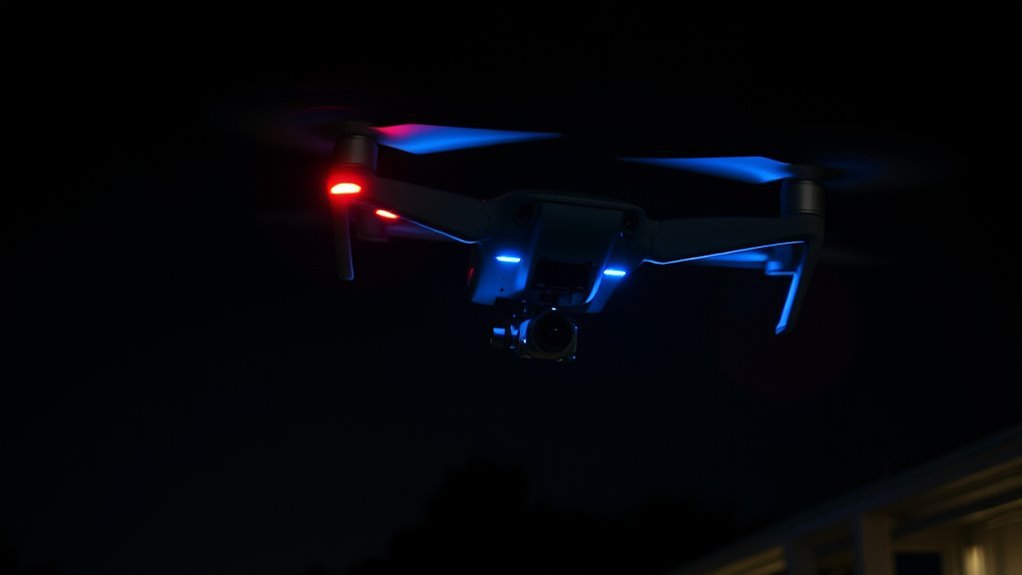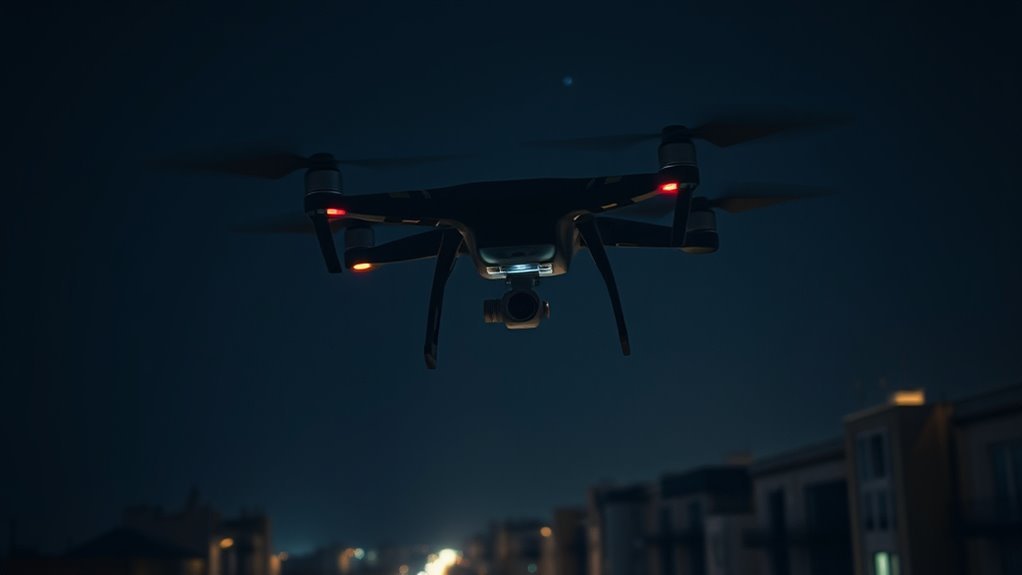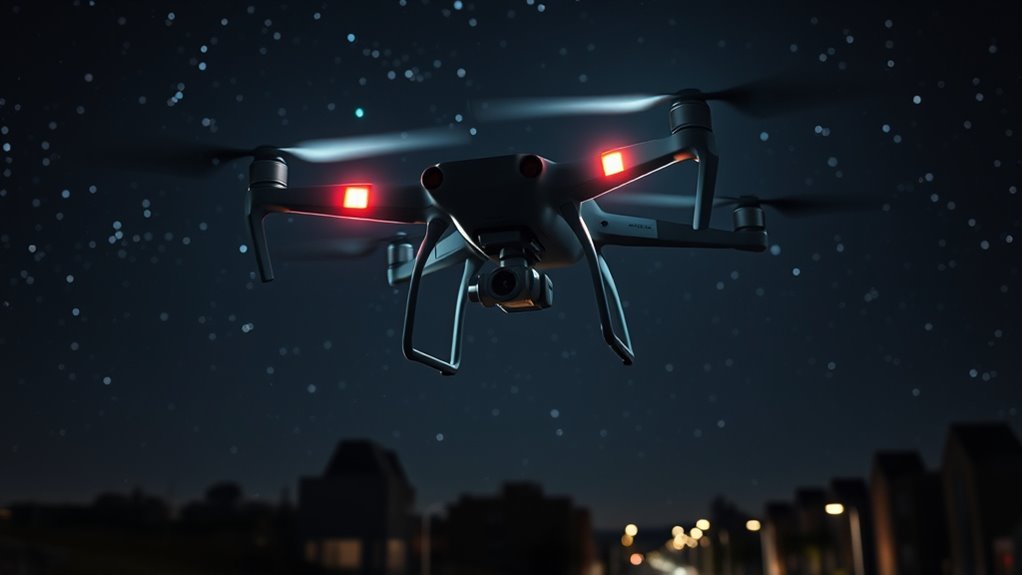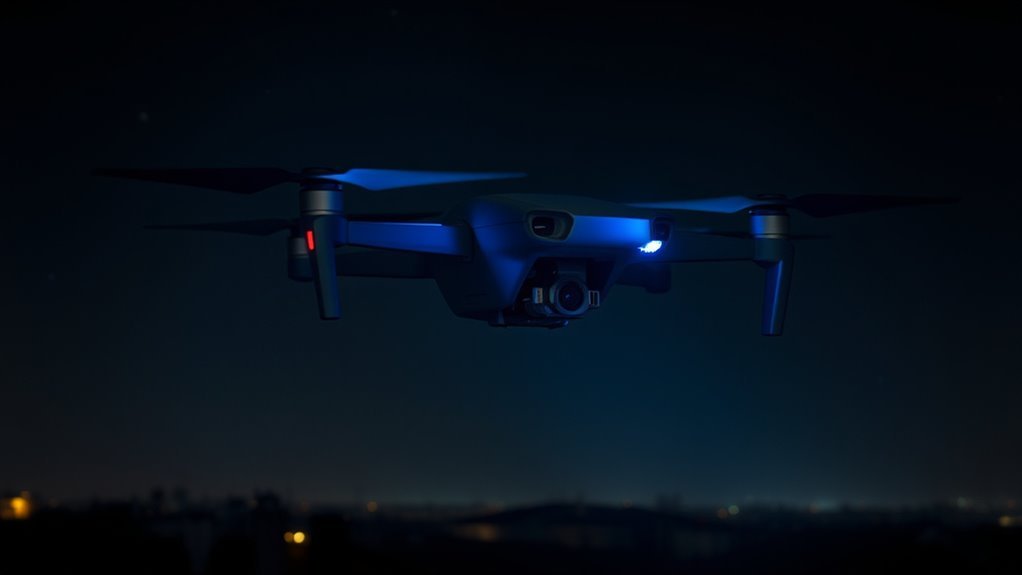At night, police drones feature sleek, aerodynamic designs that minimize drag and enhance stability. They’re equipped with infrared sensors and thermal imaging, allowing them to detect heat signatures in low-light conditions. LED lights improve visibility and safety, with strategic placement to reduce blind spots. These technological advancements guarantee effective surveillance and operational efficiency. Exploring further, you’ll uncover the real-life applications and public reactions to these drones during nighttime operations.
The Design and Structure of Police Drones

As police departments increasingly turn to technology for enhanced surveillance, the design and structure of police drones play a essential role in their effectiveness. You’ll find that the choice of drone materials considerably impacts weight, durability, and performance. Common materials like carbon fiber and lightweight metals enhance the drone’s structural integrity while reducing overall weight, allowing for longer flight times and better maneuverability. The structural design often incorporates aerodynamic features to minimize drag and improve stability during flight. Additionally, modular designs can facilitate quick repairs and upgrades, ensuring that drones remain operational under various conditions. This combination of advanced materials and thoughtful structural design is critical for maintaining the balance between surveillance capability and operational efficiency, reinforcing freedom while ensuring public safety.
Infrared Technology: Seeing in the Dark

While traditional surveillance methods can falter in low-light conditions, infrared technology enables police drones to effectively monitor and respond to incidents after dark. By utilizing infrared sensors, these drones can detect heat emitted by people and objects, making it possible to identify potential threats or locate missing persons even in complete darkness. Thermal imaging enhances this capability, allowing operators to visualize heat signatures and assess situations without relying on visible light. This technology not only improves situational awareness but also guarantees that police can act swiftly and decisively, upholding public safety. With infrared capabilities, police drones become invaluable tools, offering a heightened sense of security and freedom to communities, regardless of the time of day. Additionally, the integration of advanced safety features in drone technology further supports their effectiveness in critical operations.
The Role of LED Lights in Night Surveillance

When using police drones for night surveillance, LED lights play an important role in enhancing visibility. Their color temperature variations can greatly impact how well objects are discerned in low-light conditions, which is essential for accurate assessments. Additionally, proper integration of LED lighting is necessary for ensuring flight safety, as it helps maintain clear communication with operators and other nearby aircraft.
Enhanced Visibility Features
How do police drones maintain operational efficiency during nighttime surveillance? One key aspect is their enhanced visibility features, primarily powered by LED lights. These lights not only illuminate the immediate area but also assist in thermal imaging, allowing officers to detect heat signatures in low-light conditions. During night operations, the combination of bright white LEDs and infrared lights creates a thorough surveillance capability, enhancing situational awareness.
The strategic placement of these lights on the drone’s body guarantees ideal coverage, reducing blind spots. This technology allows law enforcement to monitor activities discreetly and effectively, safeguarding public safety without compromising individual freedoms. Ultimately, the integration of LED lights in police drones revolutionizes nighttime surveillance, making it safer and more efficient for all involved.
Color Temperature Variations
The effectiveness of police drones in nighttime surveillance is greatly influenced by color temperature variations of LED lights. Different color temperatures can affect visual perception, impacting how operators interpret images captured during operations. Warmer light (around 2700K) provides a softer glow, enhancing details in shadows but may obscure finer aspects in brightly lit areas. Conversely, cooler light (around 6500K) offers sharper contrasts, which can help in identifying objects and individuals more clearly in dim environments. Understanding these variations allows drone operators to select the appropriate lighting for specific situations, optimizing visibility without compromising operational integrity. By strategically utilizing color temperature, you enhance not only the quality of surveillance data but also the overall effectiveness of nighttime police missions.
Flight Safety Considerations
While guaranteeing effective surveillance, flight safety remains a paramount concern for police drones operating at night. Proper illumination via LED lights is essential, as it not only enhances visibility but also aids in compliance with flight regulations. These lights help you identify obstacles and other aircraft, reducing the risk of collisions. Adhering to safety protocols is crucial, as night operations often involve complex environments where traditional visual cues are limited. By equipping drones with strategically placed LED lights, you can improve situational awareness and maintain operational integrity. Ultimately, balancing surveillance effectiveness with adherence to safety standards guarantees that your drone missions contribute positively to community safety while minimizing risks associated with night flying.
Flight Patterns and Maneuverability at Night
When operating police drones at night, understanding their night vision capabilities is essential for effective surveillance. Flight stability factors, such as wind conditions and battery life, directly influence maneuverability and the ability to maintain consistent flight patterns. Analyzing these elements can greatly enhance the operational efficiency of drones in low-light environments.
Night Vision Capabilities
Although night operations present unique challenges for law enforcement, advancements in drone technology have markedly enhanced their night vision capabilities, allowing for effective surveillance and response. Equipped with thermal imaging sensors, these drones can detect heat signatures, making it easier to locate individuals or vehicles in complete darkness. This capability is essential during nighttime searches, as it enables you to monitor activity without being visually obstructed. Furthermore, the maneuverability of drones at night is optimized by their advanced navigation systems, allowing for precision flight patterns in low-visibility conditions. This guarantees that you can maintain situational awareness and respond swiftly to incidents, reinforcing the importance of technology in promoting safety and security under the cover of night.
Flight Stability Factors
Flight stability is vital for effective drone operations at night, especially in law enforcement. When flying in low-light conditions, you must consider factors like wind resistance, which can considerably impact your drone’s flight patterns. High wind conditions can destabilize your drone, causing erratic movements that compromise surveillance missions.
Additionally, battery management plays an essential role in maintaining stability. At night, the increased energy consumption from night vision systems can drain batteries faster, reducing flight time and performance. Properly managing battery life guarantees that your drone remains operational and responsive, allowing for precise maneuverability in challenging environments. By understanding these factors, you can enhance the effectiveness of your drone operations, ensuring safety and reliability during nighttime missions.
Night Vision Capabilities: A Closer Look
As night falls, the effectiveness of police drones largely hinges on their night vision capabilities, which are vital for surveillance and monitoring in low-light conditions. Many drones are equipped with advanced thermal imaging technology, allowing them to detect heat signatures from people, vehicles, or objects, even in complete darkness. This capability becomes significant during night operations, where traditional visual methods fail. By seeing beyond the visible spectrum, these drones provide law enforcement with a tactical advantage, enhancing situational awareness and decision-making. Additionally, the integration of infrared sensors guarantees that operators can maintain a safe distance while gathering critical intelligence. This technological advancement not only boosts operational efficiency but also empowers police to uphold public safety effectively after dark.
Real-Life Applications of Drones After Dark
While many people may not realize it, police drones play an essential role in various real-life applications after dark, considerably enhancing law enforcement operations. Utilizing advanced drone technology, police can conduct nighttime surveillance with unparalleled efficiency. These drones are equipped with infrared cameras and thermal imaging, allowing officers to monitor large areas without the limitations of traditional lighting. They’re invaluable during search and rescue missions, tracking suspects, or monitoring large gatherings, where visibility is critical. Additionally, drones can quickly assess hazardous situations, such as accidents or natural disasters, ensuring officer safety while providing real-time data. By leveraging these capabilities, law enforcement can act decisively, maintaining public safety and upholding community freedom under the cover of darkness. Furthermore, the integration of advanced sensors and AI algorithms significantly enhances real-time threat detection, ensuring swift responses to emerging risks. Drones also enhance decision-making for first responders by delivering critical information in real-time, allowing for more effective responses to chaotic situations.
Public Reactions to Police Drones in Low Light
The introduction of police drones operating at night has sparked a range of public reactions, reflecting both support and concern among community members. While some appreciate enhanced safety and rapid response capabilities, others fear potential overreach and loss of privacy.
| Supportive Views | Concerns |
|---|---|
| Increased safety | Erosion of privacy |
| Efficient crime response | Surveillance state |
| Community engagement | Distrust in police |
| Technological advancement | Ethical implications |
Public perception varies greatly, influencing community trust in law enforcement. Building relationships through transparency and clear communication is essential for addressing these concerns while fostering acceptance of drone technology in low-light operations. Balancing safety and freedom remains critical in shaping public opinion.
Privacy Concerns Surrounding Nighttime Surveillance
When discussing nighttime surveillance, privacy concerns inevitably arise, particularly regarding how police drones collect and utilize data. The use of drones raises significant privacy implications, as footage can capture activities in private spaces without consent. You might wonder who has access to this data and how long it’s retained. Ethical considerations also come into play; is it justifiable to monitor citizens without their knowledge, even if it’s for security purposes? The potential for misuse of collected data heightens these concerns, creating a chilling effect on personal freedoms. As you navigate this evolving landscape, it’s essential to advocate for transparency and accountability in drone operations, ensuring that privacy rights are balanced with public safety needs.
The Future of Police Drones in Night Operations
As privacy concerns loom large, the future of police drones in night operations promises to reshape law enforcement strategies markedly. You’ll likely see advancements in autonomous navigation and enhanced capabilities for tactical operations. This evolution can lead to more efficient and precise policing while raising ethical questions.
- Advanced Sensors: Expect drones equipped with thermal imaging and night vision, allowing for real-time surveillance in darkness. Furthermore, the incorporation of superior low-light performance will enable drones to gather crucial information even in challenging lighting conditions. Enhanced real-time data analysis will also support immediate decision-making during operations.
- Autonomous Flight Paths: Drones will navigate complex environments independently, reducing the need for constant human control.
- Rapid Deployment: Quick response times in emergencies will improve with pre-programmed routes and automatic takeoff and landing features.
These innovations could enhance safety and efficiency, but the balance between security and personal freedom remains essential.
Frequently Asked Questions
How Do Police Drones Navigate in Complete Darkness?
Police drones navigate in complete darkness using advanced night vision and thermal imaging technologies. These tools allow you to detect heat signatures and visualize surroundings, ensuring effective surveillance and response even when visibility’s minimal.
What Are the Battery Life Limits for Night Operations?
When considering battery life limits for night operations, you’ll find that advanced battery technology enhances endurance. Coupled with night vision capabilities, drones can effectively operate longer, maximizing their utility during dark conditions while maintaining operational efficiency.
Do Police Drones Emit Noise While Flying at Night?
Yes, police drones can emit noise while flying at night, which might affect their night visibility. The drone sound varies by model, but most are designed for quieter operations to minimize disturbance during surveillance missions.
Are There Restrictions on Police Drone Usage at Night?
Yes, there’re nighttime regulations governing police drone surveillance. These restrictions often aim to protect privacy and guarantee public safety, limiting usage hours or requiring specific authorizations, thereby balancing law enforcement needs with individual freedoms.
How Are Police Drones Maintained for Nighttime Readiness?
To guarantee police drones are operational at night, you need regular drone maintenance and thorough nighttime inspections. These processes include checking battery levels, calibrating sensors, and verifying camera functionality for ideal performance during low-light conditions.

